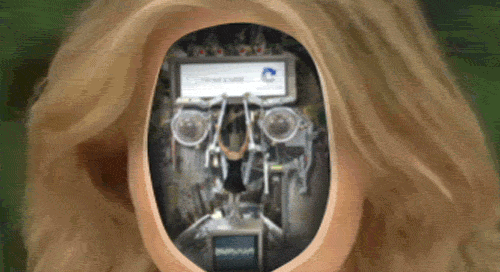📱✨The Nexialist #0132
love, forgiveness and technology will bring us to another planet | second brain | neurorights | personal machines and portable worlds | non-playable characters | humancore
welcome to another week content capturing, organizing, distilling, expressing, the nexialist
hey, you! i hope this e-mail finds you (and not a robot) well. i’m still recovering from a super social weekend and heading to another: barbie, milkshake festival, drinks with friends and the upcoming canal pride. this week in the nexialist there is a good mix of music, learning, thought-provoking pieces and trends. i’ll leave you to it! enjoy 🫀🏳️🌈
1 year ago » 👤✨The Nexialist #0081 : Renaissance | What Will Replace Religion? | Distributed Trust | How Did Consciousness Evolve? | The Earthquake That Changed History | Masters of Crowds | Three Waves of Media | The Vanishing Designer
2 years ago » 🃏✨The Nexialist #0031 : Scenius aka Communal Genius | Tropicália | Brazilian Jester | Fantastic Fungi | Getting Smarter | Europe in 1444 | WWII Dataviz | MTV Premiere | Mistress Violet
🪩love, forgiveness and technology will bring us to another planet
a few weeks ago, i shared a brazilian disco track that the algorithm brought to me on serendipity: químico amor (tn#128). now the whole album is out and it’s a blast. the sounds are delicious, and i just love the disco lyrics telling stories of today: when love and life is intermediated by technology. the title is a mouthful “love, forgiveness and technology will bring us to another planet.”
🧑💻second brain
yes, i know it’s hard to believe someone that looks like elon musk, but maybe he’s the “good twin”. tiago forte (yes, he is of brazilian —and filipino—descent) created a method to organize your digital life and unlock your creative potential, and called it a second brain, or this personal system for knowledge management. as a fan of notetaking and digital organization, i have been observing from far away his method. now big think released a 90 minutes video of him explaining the method and i had no excuse to escape. i think this is useful for anyone living in the modern world of information overload, even more so for those of us who are knowledge workers:
CODE framework: the four essential steps of the creative process. the flow on information.
capture: what’s inspiring, what evokes feelings? | practical content you know you’ll need in the future | content that is personal / life lessons, wisdom, personal experiences | surprising things. “signal in the noise”
organize: PARA (projects, areas, resources, archive)
distill: bold, highlight, filter.
express: remembering, retrieving, creating.
i have to say that i love my paper and pencil, and i have some reservations about privacy: if it is digitalized, it is potentially accessible to other people and to a corporation that might have access to very sensitive/intimate personal information. but having the potential to search, retrieve, recall and review your notes/learnings is actually a game changer.
extra: i also found detailed illustrated notes of tiago forte’s course by maggie appleton, and thomas frank’s second brain notion template, or his tutorial on how to build your own second brain using notion.
brainsparks: content diet (tn#2), self-outsourcing age (tn#17), five Cs research routine (tn#80), bullet journal (tn#10), morning pages (tn#23), knowledge curatorship (tn#14), content curation approaches (tn#54), the four C-words of the internet (tn#45)
📱personal machines and portable worlds
this post came via the sentiers newsletter and it resonated so much with me. christopher butler argues that “a lifelong fascination with technology begins with a single object.” he proceeds to show how different generations had different gadgets that opened up these portable worlds, and therefore this personability paved the way for our current fascination with our mobile devices: walkman, discman, ipod etc. for me, it was a discman, before that a gameboy and before that, a kind of electronic agenda that i didn’t even know how to use. i also remember heavily wishing a pokédex existed in the real world.
The most magical of personal devices are those which offer access to the experience of infinitude without measuring it for you. The unknown is the stuff of imagination.
That is the opposite of our most common device-based experiences today. Whether you use a phone, tablet, laptop, or any other computer, the digital “world” today is always defined by an acute awareness of measure. Of more. But more is the easiest way to obstruct the imagination. Persistent input keeps cognition at its lower levels — maintaining attention, storing memory, applying perception, and processing language — without allowing a transition to thought and learning.
The best personal device supports thought — with it, within it, and most importantly, within you. Carl Jung once wrote that “in each of us there is another whom we do not know.” The purpose of introspection, for Jung, was to become acquainted with that person — to deepen our understanding of ourselves so that we may be more fully ourselves.
brainsparks: amish tech (tn#21), resilience tech (tn#62)
🧠neurorights
i’m not kidding when i tell you this concept emerged at work on the same week i watched tiago forte’s class. i know the second brain is not considered neurotechnology, but it could be in the future, and i think it helps us see technology/privacy differently, as our mobile phones have almost become part of our bodies. it’s great to see the emergence of this field before it becomes uncontrollable: “the evolution of neurotechnology could jeopardise some basic human rights, which is why the debate about its ethical limits has given rise to the concept of neurorights.”
Neurorights can be defined as a new international legal framework for human rights specifically aimed at protecting the brain and its activity as neurotechnology advances. The concept has been developed by the NeuroRights Initiative, a platform led by the aforementioned Columbia University in New York and driven by an international community of neuroscientists.
brainsparks: scientists going into your dreams? (tn#13), centaur mindset (tn#106), how tech is reshaping male masturbation (tn#95)
🫠non-playable characters
i was so confused when i saw these videos of people repeating phrases and gestures… why? what have we become? thankfully, a post in the guardian was shared with me: $7,000 a day for five catchphrases: the TikTokers pretending to be ‘non-playable characters’. “The trend is called “NPC streaming” – named after the non-playable characters in video games that awkwardly repeat pre-programmed phrases and movements.” agus panzoni from death to stock connected it to other signals that were already popping up to help us make sense of it:
why is everyone acting like robots on TT live?! let’s talk about the sims-ification of creators… in case you missed it, real and fake-ai creators are popping up all across the internet. virtual youtubers (vtubers) are gaining popularity and people pretending to be video-game characters are going viral. the latest addition to this wave of hyper-real content is npc (non-playable characters) on livestreams, with human creators such as pinkydoll making up to US$10k/livestream for robotically repeating phrases as viewers send her digital gifts. this new format of monetization which we predicted last year is turning creators into some kind of sim. i guess lil miquela won.
for the portuguese-readers,
made an amazing analysis of this vibe: “authentic artificiality: when the question ‘is this real?’ became disposable.” they connect the success of barbie’s plastic world and other signals to this weird npc moment.in the comment section, someone mentioned baudrillard: “just as the wolf-child became a wolf by living among wolves, so we too are slowly becoming functional. We live by object time: by this I mean that we live at the pace of objects, live to the rhythm of their ceaseless succession.” is this the hyper-self-objectification/ commodification of creators (and ourselves)?
brainsparks: barbie’s authentic artificiality (#130), fake authenticity (tn#70), ontological design (tn#3), filters & fembots (tn#17)
🫀humancore
by no coincidence, the other trend emerging on the infinite sea of trends/aesthetics aka tiktok is: #humancore, as kate lindsay and nick catucci point out at
. it’s not a sudden thing, as you can find videos from last year, but fits perfectly in opposition to the (also not sudden) authentic artificiality / fake authenticity and the current artificial-intelligence-domination. what makes us human?“Humancore” becoming a thing just as we learn aliens might be real? Suspicious. —Kate
[…]
These videos, often compilations of phone-camera footage of strangers taken from afar, have received tens of millions of views in the last year or so that they started appearing. They’re snippets of regular people who don’t appear to know they’re being filmed, engaging in some kind of small, authentic human moment that just happened to be caught on camera. It feels almost like an out-of-body experience to watch them, because we don’t really have any other mechanism for stepping back and looking holistically at our own humanity. What I find most mesmerizing about them is the fact that while I’m witnessing these few moments on camera, they are reminders that so much of human life is happening entirely unseen.
i also cannot ignore that, while this is a type of content is so cute and makes us smile and warms our heart, it’s the “perfect” packaging / sugarcoating for a certain normalization of surveillance. maybe i’m just being cranky, but i had to put it out there.
brainsparks: namecore (tn#71), cozy futurism (tn#17)
see you next week, humans🫀
❓If you want to know what a Nexialist is, click here.
🔎If you want to see what I’ve already posted, visit the archive and use the search engine. Even I do that a lot.
💌I want to know what you think/who you are! Your feedback is highly appreciated; you can e-mail me or fill in this short survey. Thank you! 🙏🏻
🔌Let’s Collab?
I truly believe innovation comes from bringing improbable areas together, and that’s why I called this project The Nexialist. Some sectors are known to be self-referencing and hermetic. Sometimes teams are on autopilot mode, focused on the daily grind, which hinders innovation. As a Nexialist, I like to burst these bubbles, bringing references from different areas, and maintaining teams inspired and connected to the Zeitgeist.
I offer inspiration sessions called Brainsparks, creative desk research (Zeitgeist Boost), Plug’n’Play deals for workshops and sprints, and other bespoke formats. If you want to know more about this, send me an e-mail with your challenge(s) and we can figure something out together. Check out my website and some work I’ve done below:







